
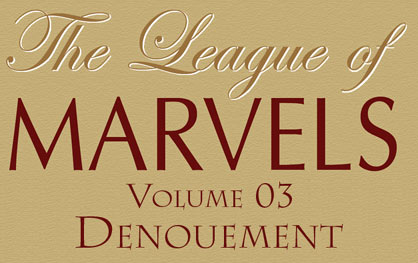
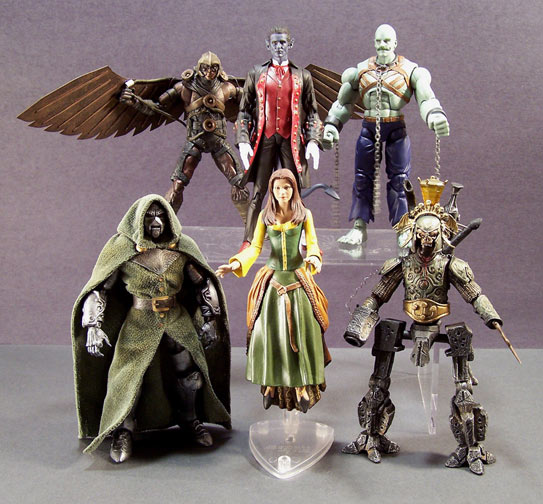
The League of Marvels
Volume 03: Denouement
A Custom Action Figure Project
By Joshua Izzo and Bruce Ross
Hasbro and Toy Biz return this spring to the enlightened 1890's for the final epic installment of their re-imagined Marvel Comics tale - The League of Marvels.
Series three of The League of Marvels, dubbed "Denouement" picks up where series two left off in terms of character selection and storyline. Each figure will again come packaged with a comic book that will wrap up the League of Marvels storyline.
The creators of The League of Marvels - Joshua Izzo and Bruce Ross - could not have been more pleased to return to the Victorian Marvel world for another exciting installment. When asked about their design aesthetics, Joshua noted that he was more interested in the society and fashion of the 1890's whereas Bruce was far more interested in the machinery and technology of the age. It was a perfect blending of sensibilities and it made for a perfect marriage of style.
The third and final wave of figures will include Falcon, Jean Gray, Dr. Doom, Vitya Brucebanof - The Incredible Hulk, Nightcrawler and a Doombot. Each of these 6" action figures will be highly articulated, and as stated above, will include and all-new League of Marvels in-pack comic book.
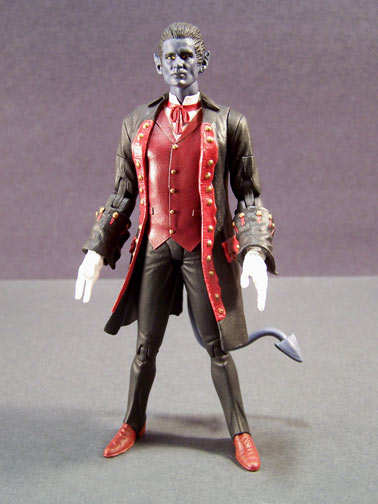
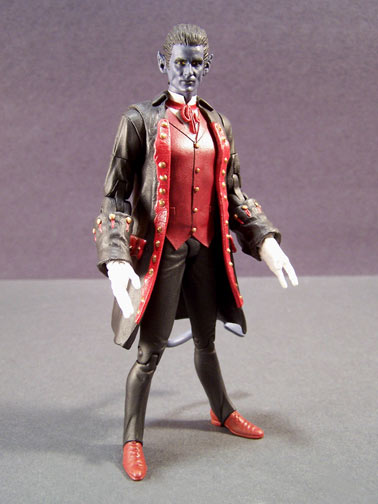
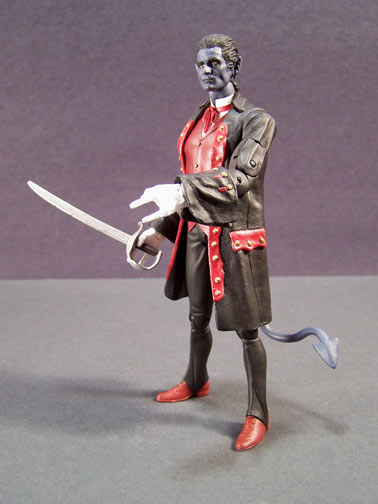
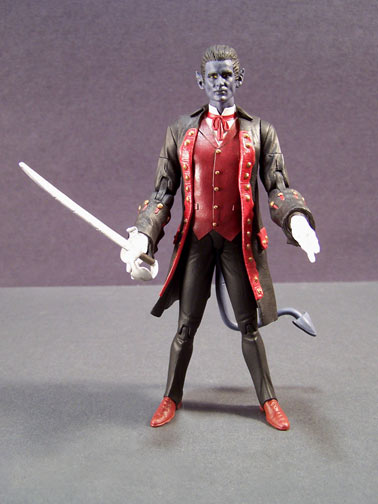
Nightcrawler -
Custom by Joshua Izzo
Kurt Wagner was born with certain unusual physical characteristics, but his power of self-teleportation did not emerge until puberty. A gypsy queen, found Wagner an hour after his birth, in a small roadside shelter in the Bavarian Alps. She found his father dead of a heart attack on the road outside. The gypsy took the baby to a Bavarian circus where she worked as a fortuneteller and all the members of the circus, who had no prejudices against "freaks", raised him.
Wagner grew up happily in the circus. Long before his teleportation power emerged, Wagner had tremendous natural agility, and by his adolescence he had become the circus's star acrobat and aerial artist. Circus audiences assumed that he was a normal-looking human being wearing a demon-like costume.
As he matured, Kurt began to grow restless at the constant traveling and near-nomadic life that he had been living since birth with the circus, and he began to long for a life outside of the tents. He looked out over the crowds every night and saw the distinguished gentleman and their beautiful companions and he wanted to join their elite company.
When he turned 18, he took his leave of the circus and bid a fond farewell to his adopted family. He began to travel across Europe, touting himself as an envoy to the ethereal realms of the otherworld. His demonic looks only added to the mystique of the pose he put on for the societies he began to travel in. Soon, Kurt found himself in the drawing rooms of some of the most influential people on the Continent. He was charming and alluring, he was suave and exciting. Men loved his lively company and the rapturous tales he spun about his circus life and women were beguiled by his looks and the mystery surrounding his origins.
He attended balls and galas. He bedeviled (no pun intended) charming ladies of society, and he entranced and entertained the courts of kings with his acrobatic prowess and abilities. After five years of establishing himself as a prominent member of the upper class European society, Kurt began to feel a slight tinge of homesickness for his family.
With the monies that he had amassed during his tenure as a court entertainer (and reckless gambler), Kurt returned to Bavaria to the circus, where he promptly bought the entire operation. His 'family' was astounded at the transformation of their young Kurt into a distinguished gentleman, but could not be more pleased that he was now running the family business, as it were.
With a renewed vigor for the life of an entertainer, Kurt took the circus on the road. But instead of playing to small villages filled with the poor and unwashed masses, he played to hundreds of thousands in the capitals of the greatest countries of Europe. It was during these tours that Kurt - now a thriving entrepreneur - began to extend his roster of circus talent. As he traveled across Europe, he began to seek out interesting peoples that could draw in the crowds for this sold-out shows.
Two notable additions to his entourage were a young Cajun woman named Jean Gray that he found traveling in a small village in Italy. She had the power to move items with her mind and to read thoughts. She was a confident and powerful woman reading fortunes in town and Kurt asked if he could recruit her as his gypsy fortuneteller. Without blinking, she accepted and they became fast friends in their shared freakishness. The second was a man named Vitya Brucebanof - whom Kurt dubbed the Incredible Hulk. He was an oddly green-skinned Russian strongman that could lift an elephant - Kurt felt a kinship for this man due to his own blue-skinned nature. These two remarkable personages helped propel Kurt's circus to the stratosphere of success.
Our tale opens with Wagner and his circus performing for the court of Prince Wilhelm in Germany. Victor Von Doom, the ruler of the European nation of Latveria and his advisors, are visiting the Prince but secretly, though, Doom is meeting with the Red Skull and the disfigured naturalist Arnim Zola. Doom, one of the financiers of Arnim Zola's mad experiments is in Germany anticipating the delivery of the first of his golem-esque war machines - his 'Doombots' - from Zola.
As Wagner and his performers begin their show, a ruckus is heard from outside the castle gates. Wilhelm dispatches servants to investigate, but before they can move, the doors to the throne room burst open and in steps Nicholas Fury and the League of Marvels.
The Prince is outraged, and he orders the intruders killed. Fury wastes no time and dispatches the League to their tasks. Find the Red Skull, find Zola and find Doom before they put their twisted scheme into action. But alas, the League is too late.
From a darkened corridor, the Doombots rise and march on the court. Fury and his team do all they can to not only protect Prince Wilhelm and his court, but to stop Zola, Skull and the ever-growing legions of Doom's army.
Wagner, from the vantage point of the highest rafter in the court looked down on the battle. He witnessed the brutal slaughter of men women and children by the unholy legions of Von Doom. He saw this own troupe being attacked and killed. He witnessed a band of heroic 'freaks', much like himself, risk everything to save innocent lives. As he was pondering what to do next he heard a thunderous crash - and looking down once more he saw that Vitya had picked up a massive oaken table and began to swat the golem-like monsters with it like a club. He turned to see Jean using the powers of her mind to aid in the fray by throwing the automatons left and right like so many rag doll toys.
With a smile on his lips, Kurt was reminded of the thrill of the circus life he led as a child. He swung from the rafters with his tail and picked up a rapier from a fallen German soldier. Teleporting close to the dandy firing piercing red beams from his eyes, Kurt began to battle the oncoming hordes. The fight had been joined!
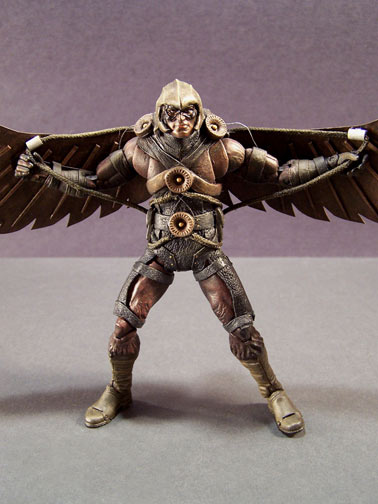
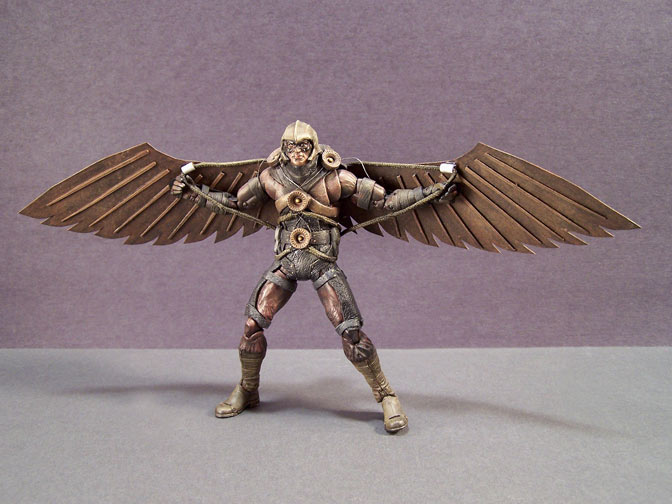
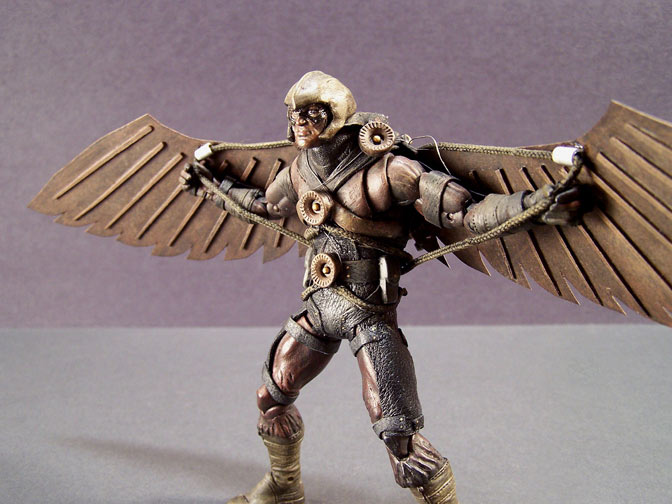
Falcon -
Custom by Bruce Ross
Upon unveiling his amazing ornithopter flying device, Samuel Wilson was taken aback when Nicholas Fury stated plainly "No one will ever know what you have achieved... there will be no glory for you, my friend."
Wilson, a man of color who had escaped slavery from the South and enlisted in the Union Army during the Civil War, had proven himself an adept and courageous leader of the Negro regiments commanded by Fury. Wilson himself had seen more victories then defeats, thanks in large part to his insistence that the Northern forces use lighter-than-air reconnaissance balloons to view the movements of the Confederate armies. The idea came to Wilson from a deep-seated fascination with manned flight, which he had developed as a child when viewing an elaborate air show that included a number of successful hot-air balloon demonstrations.
Throughout the war, Wilson oversaw the creation of numerous flying mechanisms, refining the hot air principal with top technologists and scientists who were enlisted by the government to further the cause of wartime technology. Upon seeing copies of DaVinci's concept sketches for an ornithopter (a man-powered set of wings that was designed to mimic the flight and motion of a bird), Wilson was determined to create an airborne regiment to defeat the South. His plan never came to fruition, but following the war, he convinced Fury to secretly fund and support Wilson's desire to develop such a device. Studying past and contemporary developments in flying machines from around the globe, Wilson spent years testing models and prototypes, making adjustments, and calculating how such a machine may in fact function and support a human being. As Fury began to assemble his intelligence of the growing threat from the Prussian-Latverian alliance, he presented his finding to Wilson, and pressed him to complete a working, full-scale model of an ornithopter to be used as a reconnaissance tool and, if need be, an aerial assault alternative. By the spring of 1891, Wilson had done just that.
"Why do you say that no one will know what I have accomplished?" asked Wilson.
Fury, with an edge of sadness, said plainly "The government will never let it be known that the first man to achieve flight was a Negro."
During the Civil War, Wilson became acquainted with Steven Rogers. The two men became friends beyond a level that was tolerated by society at the time. Despite their bond, Wilson was wholly unaware of the transformations that Rogers was undergoing. When Rogers himself learned of the truth that Fury was subjecting him to experimentation, his rage ended any relationship with his former mentor. Wilson and Rogers continued to be friends in the interim period between the war and the formation of the League, and it was this friendship that eventually aided in Rogers deciding to join and fight Doom and Red Skull.
As the growing conflict became all too evident, Fury dispatched Wilson to Europe to conduct aerial recon missions of key locations. Wilson did just that, and instantly proved the worth of his machine by discovering the movement of weaponry and equipment that was evidently being used for Zola's army of the undead. It was also Wilson's aerial expeditions that revealed (just in time) that a meeting had been arranged between Red Skull and Doctor Doom under the cover of a traveling circus that was conducting a tour of central Europe. The League, which had already established itself on the Continent within striking distance of Red Skull and Doom, immediately leapt into action, assembled their forces, and under the direction of Nicholas Fury, led the charge to the big top. Armed with explosive devices, Wilson took to the air, prepared to provide a bird's eye view of the coming battle and employ the first-ever aerial assault during a time of war. There was no glory for him to be had in this moment, but glory was not the objective� the objective was to save the world from eternal darkness.
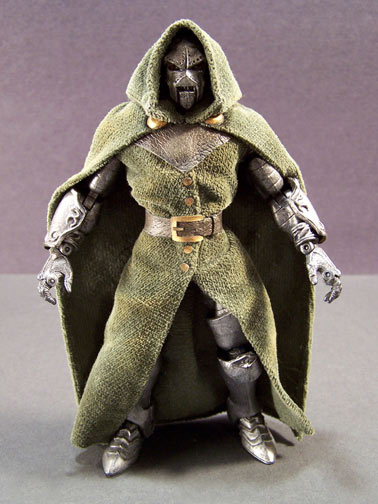
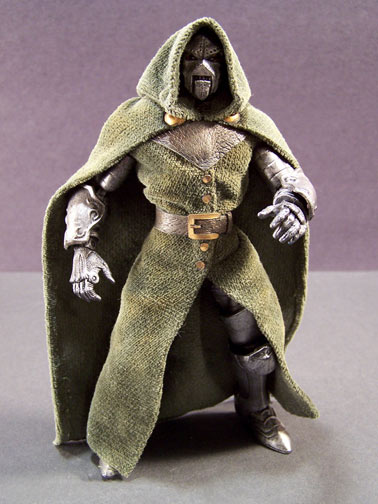
Doctor Doom -
Custom by Bruce Ross
A tyrant. A genius. A scientist. A mystical figure. Victor Von Doom is all of the above, but first and foremost, he is without a doubt one of the most dangerous figures in the annals of human history. His is a legacy of ambitions that span the globe, and of scheming against his very own allies in one of the most horrific plots to plunge the world into full-scale war. For Doctor Doom, ruler of Latveria, had finally amassed a loyal, mindless army that would carry out his will without question.
Doom, who in his younger years was a student of some of the finest educational institutions in both the United States and Europe, was held in high esteem within scientific circles the world over. Secretly however, Doom was far more interested in the Occult and the strange, mystical powers of the ancient world that fell beyond the realm of what Victorian science could explain. His thirst for knowledge was particularly piqued by the netherworld, where dead souls were without rest. Doom sought to explore and control these forces through the practical sciences, which he had believed were developed by man to conquer not only this earth, but also the multiple plains of existence. His knowledge spanned every conceivable variation on the theme of the undead, and he truly believed that, given the proper vessel, he could command a horde of lost souls to do his bidding. His experimentations involved advanced applications of all the major fields, with exposure to chemicals that would be harmful even in the smallest doses. On one such occasion, he scarred his face and most of his body, transformed from the handsome prince of a central European dynasty to a monstrous and disfigured shell of a man. When finally he returned to Latveria and laid claim to its land and government, Doom was a man transformed, a man possessed, and a man who believed that, despite ravaging injuries and years of his life spent, he had finally found a way to harness mystical control over those without physical existence and purpose.
Upon learning of Arnim Zola and his work, Doom pledged to save the bizarre and monstrous Swiss prince from the edge of poverty and publicly and proudly support his research into the creation of manufactured life. After seeing the successes Zola's work had on the battlefield during limited tests throughout the Franco-Prussian war, Doom made a pact with Schmidtt that they would develop an alliance and create an axis of power that would control continental Europe through warfare and terror. Secretly, Doom saw Zola's work as the opportunity to put his fiendish Occult knowledge into practice, and despite his alliances with Prussia and the Red Skull, Zola's hordes would in fact be subjects of Doom alone. While Zola could animate flesh and robotic mechanisms, Doom would give these vessels a consciousness that would depend upon his will to survive.
As the years progressed and Zola's army neared completion, the final plans were being laid to launch the first offensive against the unsuspecting nations of Europe. Battalions of "Doombots" were stationed throughout the bordering regions of Prussia and Latveria, one of which was stationed in a castle that was being entertained by the fabulously popular Wagner Traveling Circus. Both Doom and Skull had decided to use this occasion as the first demonstration of their undead phalanx. Unbeknownst to Skull, the final element to bring the Doombots to life lay in an incantation that only Doom knew. As he was preparing to utter the sacred and horrific words, their offensive attack quickly descended into a defensive position: a rag-tag force, obviously pulled together from all corners of the globe, charged into the circus, declaring their intention to stop Doom and Red Skull. Doom, with a twisted grin of relish below his steel mask, uttered the final words of the incantation, and let loose a force of soldiers unlike the world has ever seen. The melee that ensued would become one of the defining moments in history.
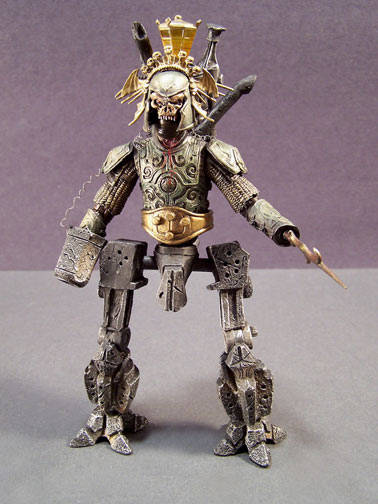
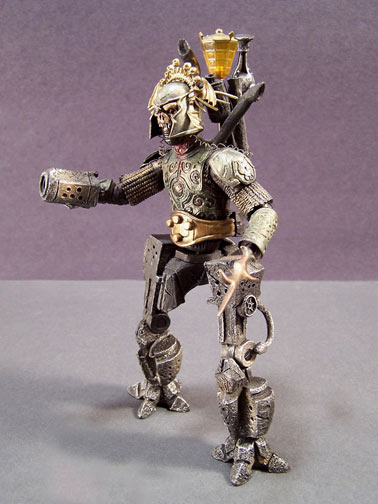
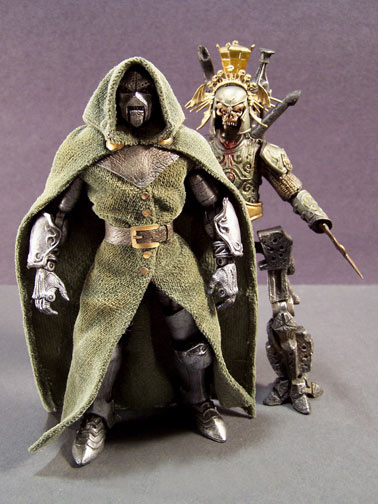
The Doombot -
Custom by Bruce Ross
The "Doombot" was the culmination of decades of research, lives sacrificed, and every waking moment of Arnim Zola's life. Using dead flesh and artificially generated organic, living tissue with coal and steam-powered robotic elements, the end result is an armored terror that requires a tremendous amount of effort to destroy. The life cycle of a Doombot begins with a tremendous output of initial energy generated by a super-hot coal boiler. This starting burst of energy powers a "perpetual motion" mechanism that allows a steady flow of oxygen to feed the living tissue and operate the robotic legs and pneumatic harpoon mechanism. In addition to the harpoon mechanism attached to the left hand, Doombots are armed with a miniature cannon on the right hand that can be converted to fire a variety of projectiles, and even has the ability to be converted into a flamethrower. There are also convertible attachments on each Doombot for a portable Maxim machine gun.
The Doombot possesses lower brain functions (and has a fully operational autonomic nervous system) as well as some rudimentary higher brain functions. But what gives the Doombot its "consciousness" is the direct word of Victor Von Doom's mysterious and ancient incantation. By uttering these words, Doom is able to wield and control the collective whole of his troops by channeling the untold forces of restless, bodiless souls from the netherworld. This fact is unknown to Red Skull, and while Zola is aware on some level of Doom's conceit, he does not know the level of power that Doom possesses over these minions. While this does allow Doom a tremendous amount of control, and the physical strength of the Doombot does make them extremely hard to destroy, these abominations are not able to make complex choices or adapt quickly on the battlefield. The price of their loyalty and strength is that of intelligence and critical thinking.
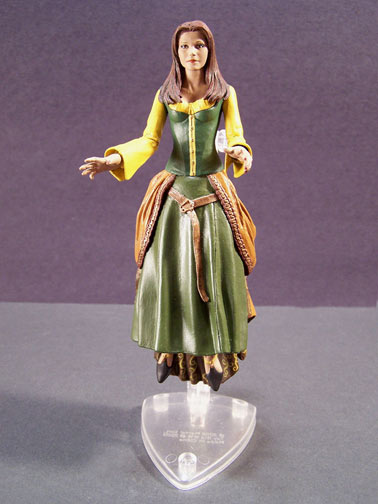
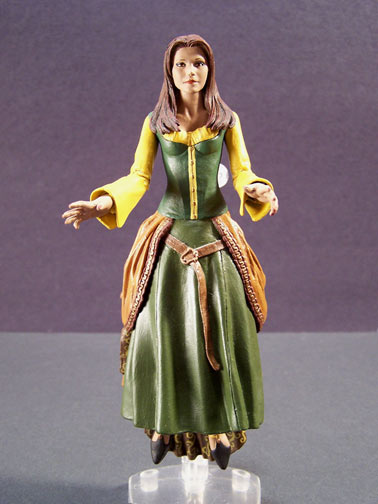
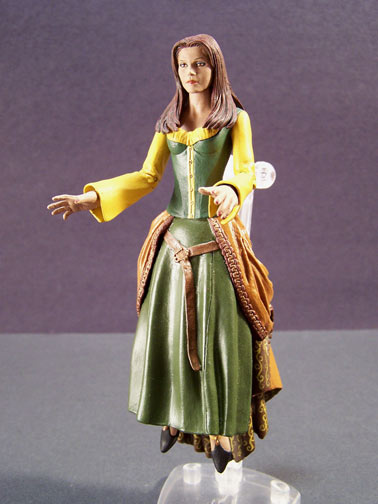
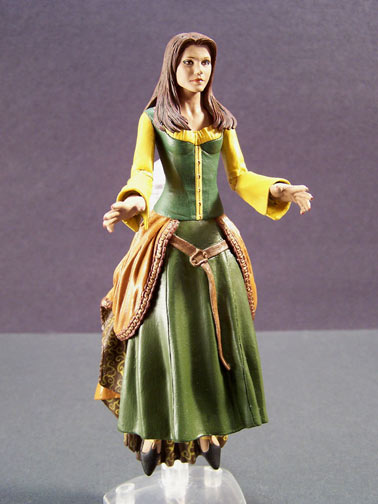
Jean Gray -
Custom by Joshua Izzo
Marie Darkholme was born in 1847 and why or when her mother (unknown name) chose her for the role, as Voodoo queen of New Orleans - or whether she chose it for herself - remains a mystery. However, in the second half of the 19th century, the position of the Darkholme's had become so lofty in the Voodoo world that Marie was in that late period not just a mere queen. She was much rather sort of the 'queens of queens,' with less important women working under her guidance. Marie had many profitable activities. For one thing, she greatly increased the reputation of the name of 'Marie Darkholme' as a procuress. Her mother had built the Maison Blanche and had sometimes arranged meetings between with men and colored girls. Under the rule of Marie, the affairs at the Maison Blanche dramatically increased, and sometimes even some of the city politicians were among the guests. The Darkholme ways of performing homeopathic magic were endless. Sick people were often brought to the St. Ann cottage to receive the benefit of a cure by Marie.
All in all Marie charged high prices for her services, though the amounts varied according to the wealth of her client. Everything was very businesslike. She owned the Maison Blanche but she was an outcast from her family who forced her to leave St. Ann cottage. So Marie lived in the Maison Blanche for some years and earned most of her living arranging meetings between white men and mulatto girls.
It was in the year 1874 that a fateful meeting occurred at Maison Blanche. A gentleman of discerning taste visiting from Oxford was looking for some nightly entertainment and was persuaded by his colleagues to visit one of the acclaimed Voodoo ceremonies they had heard so much about at their oaken-wood paneled clubs back in London.
Young Charles Xavier made his way the underbelly of the French Quarter and as if through some preternatural means, he found his way to Maison Blanche. Charles, being an adventurous sort made his way into the antiquarian mansion and soon found himself face to face with Marie Darkholme. Marie and Charles, as if drawn together by forces beyond their control spent that night entwined within a loving embrace. An embrace that would - after Charles made his way dreamily and hazily back to his colleagues the following morning - produce a most startling outcome... nine months later...
Jean Gray Darkholme, a mulatto, was born in 1875. She was a gorgeous child, full of life with shining amber and red flecked eyes, long ruddy hair that flowed over her shoulders like blood and a soft mocha-colored skin that half-way between light and shadow. Her childhood at Maison Blanche was filled with rituals and ceremonial rites associated with her mothers religion.
As she grew up, her beauty became even more radiant and she became an integral part of the Voodoo religion at Maison Blanche. As she matured, she began to take on more and more responsibilities of her mother. She learned many secrets, some of which she learned during her time with he mother, others still being acquired, with the help of her agents who she had planted in many important households throughout the city. Her control over blacks became almost absolute, and she had different ways of acquiring it.
Creole ladies came to her usually in regard to love affairs, and carried away her love powders, amulets and other gris-gris. By the mid 1880's Voodoo was at its height in the city, and Jean Gray Darkholme was now its essence. It is probable that nearly all black servants had some connection with the cult. Although the St. John's Eve gatherings near the lake and Bayou St. John became, under Jean's direction, a little like 'shows' staged for the benefit of the curious whites, they were by no means anemic affairs.
It was at one of these gatherings that Jean realized that she was more powerful than Voodoo priestess that had ever come before her. It was one night, when gathered around a massive altar which was surrounded by her offerings, such as chickens, cakes and rum that Jean - The Voodoo Queen - began to hear voices. Not just the voices of her followers aloud, but the voices within their heads and hearts. She learned their darkest secrets and most intimate fears. She learned their deepest wishes and whom they longed to kill. Jean could not contain the thoughts in her head any longer, and as the dance grew to a fevered pitch, she screamed aloud into the bitter New Orleans air. With that scream, she fully awoke.
Jean opened her eyes and was astonished to find that the world around her was frozen. But not only frozen in time, but lifted off the ground� She walked through her followers, and reached out to their minds. She called forth their thoughts and with a whisper of her mind, she could move them. Move them as far as her minds eye could see.
Jean brought the ceremony to a close that night, and went back to Maison Blanche to contemplate her new life and when she returned home, she found her mother dead. Jean, now a young woman, found her life in New Orleans to be unbearable and hollow. She found no solace in silence, nor did she find solace in religion - neither Voodoo nor Christian.
Although she had trained many women in the art of Voodoo, the denizens of the French Quarter were not happy with Jean's decision to leave New Orleans. Although the pleas of her following were sincere, Jean knew that she needed to seek out peace. The voices in her head were a constant searing pain, and tempering the power to move objects with her mind was a slow-going and strenuous process.
Dropping her surname of Darkholme, Jean left New Orleans and began her new life as a traveler. She went to Europe and sought out wizened gypsies in the old countries of Bavaria, Russia, and Latveria. She trained her mind and learned to control her mental powers to such an acute degree that she could move objects in rooms hundreds of miles away, had she been there previously.
She was in a small village in southern Italy in the summer of 1894 when a blue skinned, pointy eared and long-tailed gentleman in immaculate evening wear walked into the tavern she was practicing her craft in. She was working as a gypsy fortuneteller and was immediately entranced by the blue-skinned man's presence. She read his thoughts and learned he was searching for something... in fact... he was looking for her!
He walked over to her and they began to speak. She immediately felt a kinship to this Kurt Wagner, due to his amazing appearance, but when she learned that he had abilities like her own; she felt a bond more akin to family. He asked if she wished to leave the solitary and nomadic life behind and join his circus as their resident fortuneteller. Without hesitation, Jean accepted and the circus gained a new daughter.
With thanks and apologies to Barbara-Simone Brandst�tter. Facts taken from "Voodoo in New Orleans" http://www.bradley.edu/las/eng/lotm/Voodoo/index.htm.
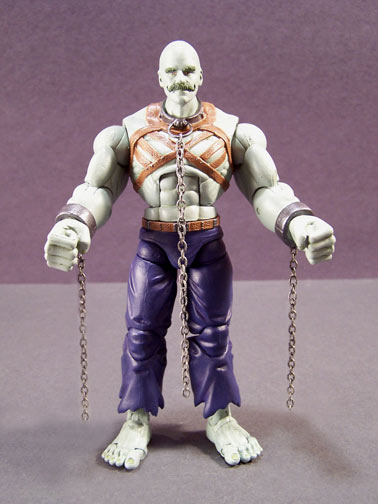
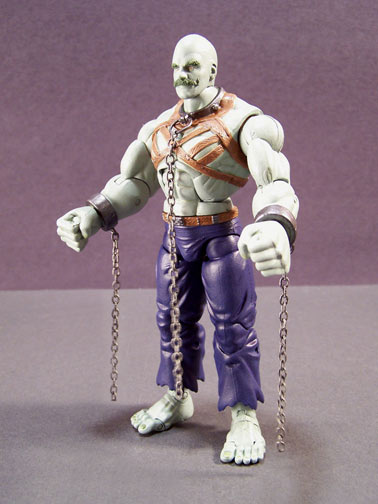

Vitya Brucebanof - The Incredible Hulk -
Custom by Joshua Izzo
Throughout the last half of the nineteenth century, Russia's economy developed more slowly than did that of the major European nations to its west. Russia's population was substantially larger than those of the more developed Western countries, but the vast majority of the people lived in rural communities and engaged in mining and agriculture. Industry, in general, had greater state involvement than in Western Europe, but in selected sectors it was developing with private initiative, some of it foreign. Between 1840 and 1900, Russia's population doubled, but it remained chiefly rural well into the twentieth century. Mining and agriculture remained in the hands of former serfs and former state peasants, who together constituted about four-fifths of the rural population. Large estates of more than fifty square kilometers accounted for about 20 percent of all farmland and most were the mine owners, but few such estates were worked in efficient, large-scale units.
By 1850 when iron and later steel became important the Russian coal industry had long been established, and used steam engines for pumping. The Russian coalfield lay near the navigable River Dnieper, so coal was shipped downstream to the ports and cities of the Black Sea delta. Deep mines were not required at first so there were a large number of small operations. Entrepreneurs started going deeper and deeper (thanks to the good pumping system). Gas explosions were a serious problem, and Russia had high fatality rates. By the late 19th century the seams were becoming exhausted and industry was importing some coal from the Ruhr in Belgium.
It was in this mine that the life of Vitya Brucebanof began. His father, Fyodor, was a miner in one of the richest seams of coal on the northern banks of the River Dnieper and worked there his entire life. He was a solid, sturdy man with a healthy wife and four children. It was one day as he was chipping away some loose slate when something caught his eye. As he moved some of the shards of shale away, the interior of his particular segment of cavern began to become illuminated with an eerie green glow.
Moving down towards the rock bed, Fyodor noticed that there was a healthy growth of a bioluminescent fungus growing in a now-opened pocket of the cavern. He was astonished at how the fungus gave off its own light and was even more pleased when he discovered that the fungus could be collected and would retain its luminous properties. He finished his day at the mine, and before he was brought to the surface, he collected a sample of the fungus to show his wife.
As like her husband, Raisa Brucebanof was amazed at the discovery. She promptly took the fungus and placed it in an old glass jar that was filled with dried flowers. She examined the strange growth and was pleased at how it lit up their small cottage. Fyodor's other children enjoyed the novelty as well - and begged their father to bring home more of the strange fungus for their own rooms.
As per his family's wishes, Fyodor brought home as mush of the fungus as he could carry in his rucksack the following day, and soon their home was filled with the glowing green fungus. When it was evening, their cottage became the center of attention in their village due to the otherworldly glow that emanated from the windows. Fyodor and Raisa were happy with their newfound position in town, but their luck began to soon turn.
Within weeks of the fungus arriving in their home, the youngest of their children began to become tubercular. Shortly thereafter, all of the children were bed-ridden, their bodies wracked with coughing fits and their shirtfronts stained with blood. Raisa, was distraught, but was even more petrified when she learned she was pregnant again. Fyodor was at his wits end at how his family was falling to pieces, and in a fit of drunken rage went down to his mine shaft and was found the next morning dead, and buried in a pile of rocks.
Raisa and he family continued to disintegrate. Her children all perished and soon she was at the point of the birth of her new child. The labor screams were heard throughout the region as she struggled with the birth of her last child. She was alone in her cottage since the family was branded as cursed by the locals and the only comfort she had was the soft, luminescent glow of the green fungus. When the child was born, Raisa was in a state of delirium, though she was happy to see that the child seemed healthy and normal�.for now.
When Raisa awoke the next day after her child's birth, she believed she was still asleep. She looked at her new child and he was green. It was not a trick of the light. It was not her post-partum delirium or the loss of blood. Her son was green. He was a shade of pale green, almost the color of pale spring grass and his eyes shown with a deep, ruddy hue. He was 'normal' in every other way - ten finger and toes, a healthy appetite and an even healthier set of lungs.
The one thing she noticed as she composed herself and began trying to make sense of this new wrinkle in her life was that her son - whom she named Vitya after her father - was inordinately strong. When he grabbed for her, he left bruises. When he rattles his crib, he broke loose the spindles and Raisa was horrified by what he did to their cat.
Due to the unfortunate circumstances of their life, Raisa was forced to leave her home and move herself and Vitya to a small neighboring village where they knew no one. Vitya grew up amongst shepherds and farmers, and was raised as any normal child would have been raised. He soon became a novelty amongst the locals due to his ability to plough fields without an ox and to move stones and up-root rocks from the fields. He soon became a local celebrity.
During his adolescence, Vitya grew more powerful and sincere in proportion to his size. He was as big as an ox, and ten times as strong. But for all his strength and his simple ties to his life, he could not save his mother. Finally succumbing to the same body-breaking disease that ate away her family, Raisa, around Vitya's 18th year, began to become tubercular. She died in the winter of 1877.
In the spring of 1878, Vitya moved to the capital city of Moscow, and although green-hued in skin, was allowed to enter the army. There, he aided mother Russia in ending a short war with the Ottomans, and also aided in the extension of its Armenian territories, also regaining Bessarabia. Because of his might, Vitya was a distinguished soldier and was given all the accolades associated therewith.
It wasn't until 1890 that Vitya grew weary of the life of a soldier, and he longed to regain the innocence of his youth once more. Leaving the army, Vitya once more traveled to the Russian countryside to begin a new life as a simple peasant once more. His life, though, would not let him rest all that easily.
On his way to his new home one day a highly excitable child stopped Vitya while walking down the road. The child explained that he was from a circus that was making its way through the region and a storm has washed out the roads, leaving them filled with mud. Their carriages and carts were stuck fast, and they needed as many able-bodied men as they could find to aid them in rescuing the animals and equipment.
Vitya, being a kind-hearted soul offered his aid, and not one of the troupe blinked an eye when a green-skinned man came to their aid. They DID blink though, when that same green-skinned man lifted their carts and equipment out of the mire with nary a bead of sweat breaking on his viridian brow.
The ringleader and owner of the circus, a similarly off-colored man named Wagner approached Vitya with awe. He asked if Vitya was attached to the life he was leading. Vitya answered that his life was at the whim of the fates, and it seemed that fate brought the two multi-skin-colored men together. After a night at the performance and a few drinks, Vitya and Wagner became the fastest of friends.
The following day, Kurt Wagner invited Vitya to become the circus strongman, and with the thought of peasant life disappearing faster and faster from his mind, Vitya happily accepted. He was dubbed 'The Incredible Hulk' due to his size and power, and he amazed people of all ages with his feats of strength for years and years...
The year is now 1895, and Vitya, his closest friend Wagner and a woman named Gray find themselves embroiled in a conflict that could very well decide the fate of all mankind. As Vitya moved through the throngs of golem-like warriors in the Prussian Princes' palace, he could think of no better life to lead than this...
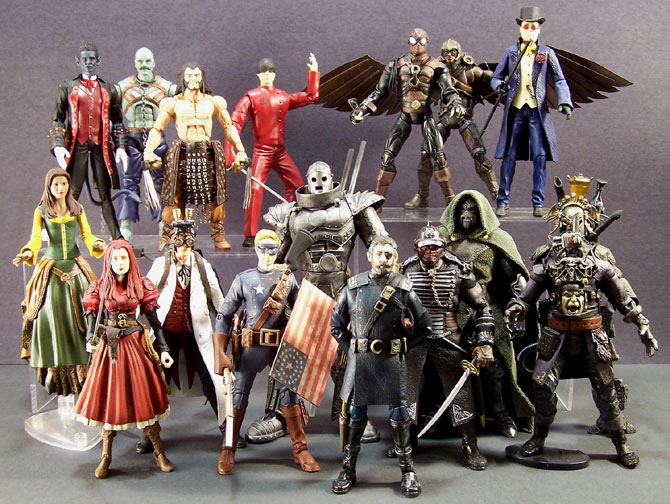
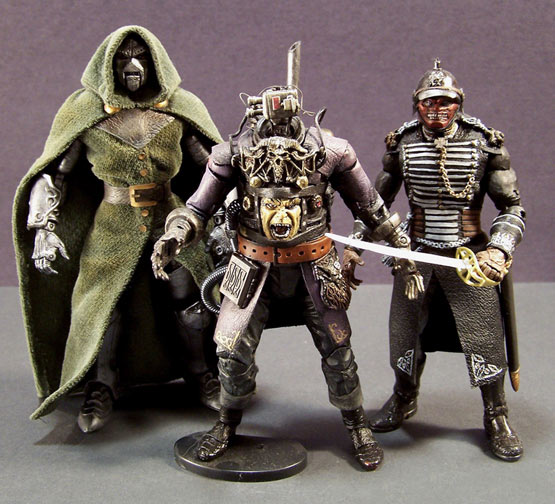
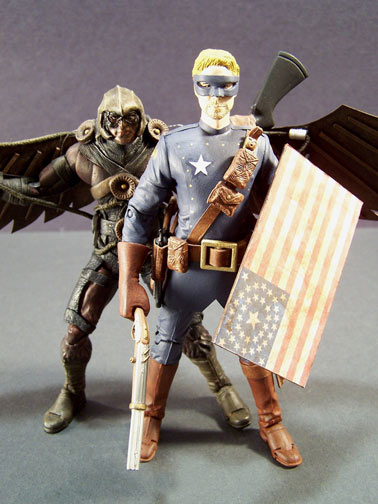 Learn more... (see the recipes)
Learn more... (see the recipes)
Back to the CustomCon16 main page Back to Custom Central
[FAQs and Articles] [Custom Site Links]
[Custom Central Galleries] [Custom Talk]
|









